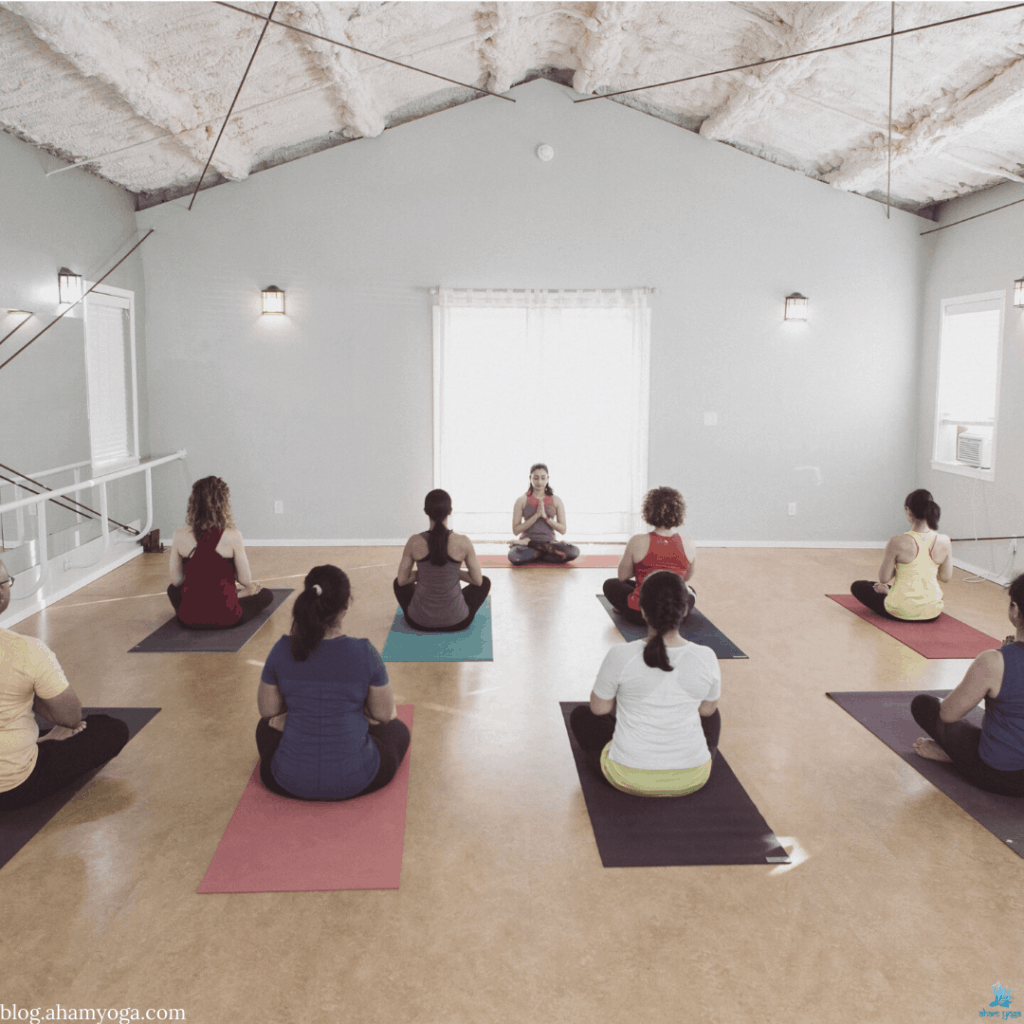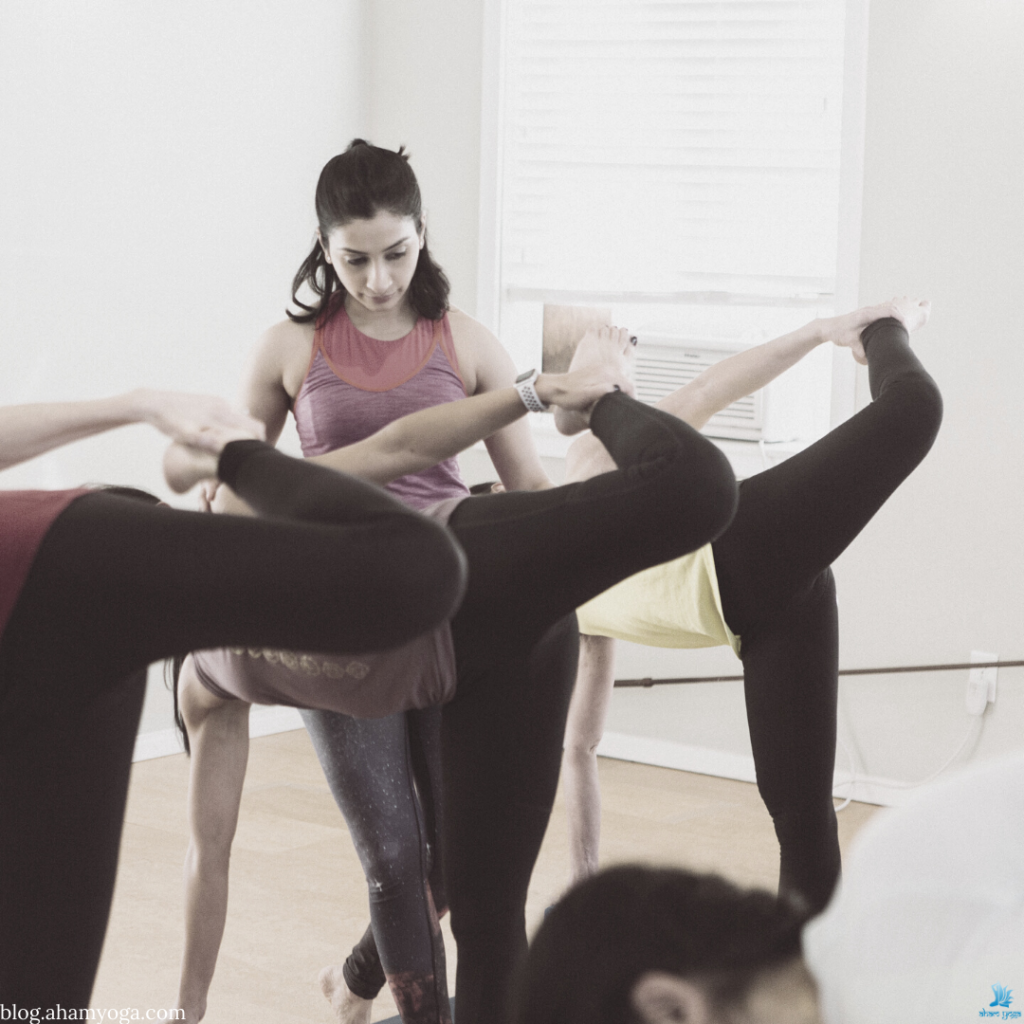I’ve been teaching beginners’ yoga for as long as I’ve been teaching yoga—almost a decade now. It’s one of the hardest but also the most rewarding levels to teach. Below I will walk you through all that you need to know and do when you are teaching someone who is new to yoga.
What’s at stake when you’re teaching beginners?
When we teach beginners, we need to remember that we only get one shot at a first impression. As the first yoga teachers they meet, we can either make them love yoga—or possibly dislike it forever. Most people will only try yoga once, or at best twice, in their lifetime. That’s it.
It’s important to remember this as we teach. Teaching a beginner’s class is hard work. It’s often feels easier and more rewarding to teach those who already know what yoga is about—but see this as a golden opportunity to serve someone with all that yoga has to offer.
Anyone who starts yoga today begins with learning asana, i.e., the physical practice of yoga. Asana is the third limb of yoga; there are 8 limbs in total according to Patanjali’s ashtanga yoga mentioned in the yoga sutras. Here we will focus solely on how to teach asana to someone who walks into a yoga class as a beginner.
Understand the mindset of the beginner
Beginners are perhaps…
- Curious
- Nervous
- Excited
- Confused
- Ambitious
- Unsure
- Reluctant
It takes a few sessions to get the beginner student to settle in. But as their yoga teacher, you want to move them from confusion, doubt, and nervousness to a state of clarity, control, and enjoyment in their practice. The more we’re able to build a rapport and connect with our students, the easier it will be to bring them back to learn more yoga.
Some easy ways to build rapport and trust are:
- Learn their names
- Ask if they have any past injuries or medical history that you need to be aware of. Make sure to remember these details when you teach. Follow up afterward and ask if they felt okay in class
- Watch the student’s practice and help them improve their poses
- Notice where they get stuck and see if you can help them get unstuck. For example, if a student is struggling in vrkshasana (tree pose) think of ways in which you can make the pose more accessible. For example, suggest that they use a wall, lower the leg, fix the gaze, etc. Also remind them that it’s completely natural to fall in these balances
- Smile at your students and maintain eye contact
- Make sure no one gets ignored in class
- Help them to stay involved and do more yoga after the series ends

How do we explain what yoga is to a beginner?
The honest answer is we can’t explain fully what yoga is in the short span of a typical asana class. But we can explain a few interpretations of yoga. Or clear up some misconceptions. Here are some of the things I often share with beginners…
“I can’t teach you all of yoga in a few hours. It’s like trying to master a musical instrument: Yoga is a skill that gets better with practice.”
“You don’t need to be flexible to do yoga. That’s just a misconception. Flexibility has nothing to do with yoga. Though, as a result of a consistent practice, you may eventually become flexible in body and mind.”
“There are many ways in which we can practice yoga. One way is through the physical practice, aka asanas, but there are other very important aspects, like lifestyle and philosophy, that we won’t be able to get to fully in this course. We’ll be focusing on asanas first as nowadays the body is the entry point into yoga.”
“There’s no measure of being “good at” yoga. Try not to make comparisons or be hard on yourself. It’s really not about how good your pose looks on the outside. It’s more about how you feel about what’s happening on the inside. Try not to compare yourself to others.”
“Yoga helps you to eventually become more mindful. It starts by listening to the instructions and trying to do them as best you can. It’s normal to get distracted; just bring yourself back each time.”
What do yoga teachers need to bring to class?
- A compassionate, respectful, and generous attitude
- All their yoga props
- A well-prepared sequence with options for all abilities
- Pure intention
- The ability to be fully present with the student
- No distractions
What do students need to bring class?
- A non-slip yoga mat. If you notice the mat the student uses is slipping, please remind them to buy another mat as their safety is key. It’s hard to do any yoga pose well without a good mat as it can distract from the practice
- Two extra-firm yoga blocks (this is important as some foam blocks are softer and can bother the wrists)
- A yoga strap
- A yoga blanket or cushion to sit on
What should students wear to yoga?
- Clothes that allow the body to stretch and move freely
- Practice is barefoot. Ask them to remove any socks
- No jeans
Common Questions Students Ask
- How long before class can I eat?
We recommend a gap of 2 hours after a heavy meal before doing asana practice as otherwise you can feel nauseous during twists, backbends, and inversions.
- I’m on my monthly period; Can I do yoga?
Yes! In fact, yoga will help make any discomfort of the periods eventually go away. We definitely recommend you do yoga when you can. Beginners’ yoga is gentle and it will be helpful to you to move, breathe, and stretch.
- What yoga mats do you recommend?
We love Jade yoga mats.
- What can I practice at home?
We recommend you wait for a few weeks and first learn the poses in class well. Once you’re familiar with them, the instructor will offer you some poses to do at home between classes.
- My child wants to do yoga with me? Is this okay?
Our classes are suitable for anyone above the age of 16. If this applies to your child, please go ahead and enroll them.
Sequencing for a Beginners Yoga Class
Sequencing for a beginners’ class is easy but can be tricky, especially if you’re a new yoga teacher. Here are some key things to keep in mind…
- Beginners need movement more than long holds. Long holds will make them bored and uninterested. Remember to keep a steady pace throughout.
- Things to include in each class would be: some hip opening, simple twisting, sun salutation preparations, breath focus, side bending, chest opening, hamstring stretches, and rest.
- The class should be doable but also slightly challenging. The student should feel successful in every pose.
- Teach alignment first; breath comes later.
- Watch the students as they move through what you’re asking them to do. This will really help you understand how well they’re able to execute your sequence.
- Remember, you’re not a robot, nor is your student. Have conversations with them about how they’re doing after class or during challenging poses.
- You should see them progress from one class to the next as their understanding of the practice grows. Repetition is important for beginners.

Yoga Poses for Beginners
This a pose bank for beginners. Needless to say, depending on the age, time of day, and physical and mental capacity of the student, some poses are more accessible than others. Remember to teach the person in front of you. It’s not about teaching the pose. Anyone can teach a pose; very few understand how to teach the person doing the pose. If you can teach the specific person in the pose each time—making it accessible to them—you will be successful in teaching beginner’s yoga.
The following poses are listed in no particular order. They can be modified to any extent with the help of props. This is where your expertise, training, and knowledge comes in.
These are the easiest for most beginners. They are also a great place to start. Most beginner yoga classes will have a lot of standing poses as they’re the foundation for a lifelong successful asana practice. Standing poses make the body strong and the mind alert and they enhance breathing as well as body awareness. Here are some basic standing poses to consider…
Standing Pose List
- Tadasana
- Virabhadrasana 2
- Parsvakonasana
- Trikonasana
- Prasarita Padottanasana
- High lunges
- Anjaneyasana
- Adhomukha Swanasana
- Vrkshasana
- Pigeon prep
- High plank
- Uttanasana
- Parighasana modified
Backward Bending Pose List
- Marjari
- Vygrasana
- Marjari (alternate arm and leg)
- Bhujanga
- Urdhva mukha swanasana
- Setu bandhasana
Seated Pose List
- Baddhakonasana
- Sukhasana
- Side stretch in sukhasana
- Sukhasana twist
Supine Pose List
- Figure 4 stretch
- Supta padangushtasana
- Ananda Balasana
- Jattara Parivrattanasana
Your class is not limited to these poses. You can add or remove poses as needed. If your student needs a gentler practice, opt for some chair yoga poses or simple joint movements. You should be able to better gauge a student’s ability as your gather more experience.
If your student needs more, teach classical surya namaskar. But remember to break it down into stages. Teaching it all at once is a lot for the student. It’s also overwhelming for you. Aim for clarity and accessibility when you teach.
All classes must have some seated silence at the start to help ground the students and also end in shavasana.
Things to keep in mind
- Modifications for back issues
- Wrist modifications
- Neck stiffness
- Knee issues
- Ask if any student is pregnant
How many classes should we teach for Beginners Yoga?
It depends on the capacity of the teacher and the student. But an average of 8 one-hour sessions is good to give beginners a foundation before they move on to the next level of practice. If anyone feels like they’re not ready to move on, they can repeat the beginners’ series again.

